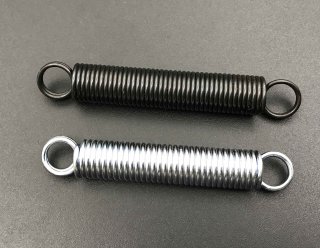A branded online store
under Lanqiaoying Technology
hotline
135-1094-6032
Why do stainless steel tension spring springs need to be surface treated? What else do you need to do after the surface treatment? What is the effect of galvanizing? I believe you have not found a suitable answer after seeing these questions. Generally people think that galvanizing is just for beauty, but everyone I don’t know that galvanizing has other effects besides beauty. Next, let me explain why stainless steel spring springs are galvanized!
1. Why should the stainless steel extension spring be galvanized?
(1) Generally, the galvanized layer is passivated after plating. Passivation can improve the protective performance of the coating and increase the appearance of the surface.
(2) The thickness of zinc and cadmium coatings determines the level of protection. The thickness should generally be selected according to the working environment during use. The thickness of the zinc coating is recommended to be selected within the range of 6-24/μm; the thickness of the cadmium coating is recommended to be selected within the range of 6-12/μm.
The role of spring galvanizing
(3) The zinc and cadmium plating of the stainless steel spring spring is carried out in the cyanide electrolyte. In the electroplating process, in addition to the zinc or cadmium plating, a part of the reduced hydrogen penetrates into the plating layer and the crystal of the base metal. In the grid, internal stress is caused, and the coating on the spring and the spring become brittle, which is also called hydrogen embrittlement.
(4) Due to the high strength of the spring material, coupled with the large deformation of the spring during forming, it is particularly sensitive to hydrogen embrittlement. If the hydrogen is not removed in time, it will often cause the spring to break. In order to eliminate the occurrence of the electroplating process For some defects, to improve the physical and chemical properties of the spring, prolong the service life of the spring, and increase the corrosion resistance of the coating, post-plating treatment must be carried out, that is, hydrogen removal treatment.
(5) The hydrogen removal treatment is carried out immediately or within a few hours after electroplating. Heat the electroplated spring at a temperature of 200-215°C for 1 to 2 hours (or more than 2 hours) to achieve the purpose of hydrogen removal.

2. What is the function of the surface treatment of stainless steel extension springs?
(1) There are many types of metal protective layers. For springs, electroplating is generally used to obtain metal protective layers. The electroplated protective layer can not only protect from corrosion, but also improve the appearance of the spring. Some electroplated metals can also improve the working performance of springs, such as increasing surface hardness, increasing wear resistance, improving thermal stability, and preventing radiation corrosion. But if it is purely for the corrosion of the spring, the electro-galvanized layer and the electro-cadmium layer should generally be used.
The role of spring galvanized.
(2) Zinc is relatively stable in dry air, hardly changes, and is not easy to change color. A white film of zinc oxide or carbon zinc carbonate is formed in humid air. This dense film prevents further corrosion. Therefore, the galvanized layer is used as the anti-corrosion protection layer of the spring under normal atmospheric conditions. Zinc coating is not suitable for springs that are in contact with solutions such as sulfuric acid, hydrochloric acid, caustic soda, and working in humid air such as sulfur trioxide.